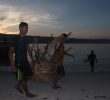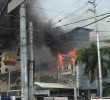K. EAST KALIMANTAN
The East Kalimantan coast, from Samarinda through Takaran, Nunukan and the Malaysian port town of Tawao in Sabah, has had a small JI presence and a larger support network since the mid-1990s and grew substantially during the conflict in Poso. East Kalimantan was also a major route for Indonesians going through Sabah to Mindanao for military training, although two non-JI organisations, KOMPAK and Darul Islam, had their own networks up the coast. This area probably contributes ten to fifteen people to overall JI strength but to Crisis Group�s knowledge it has never had a wakalah as such.
L. THE PHILIPPINES, MALAYSIA AND BEYOND
The JI structure in the Philippines is murky but new information reinforces previous Crisis Group analysis that the mainstream JI members who ran the Hudaibiyah wakalah under Mantiqi III and whose primary alliance was to the Moro Islamic Liberation Front (MILF) have little to do with the �fugitives� working with the Abu Sayyaf Group. The latter, about nine in all, includes two JI men with major U.S. government bounties on their heads, Dulmatin and Umar Patek; Asep alias Darwin, who fled to Mindanao after the 2001 Atrium Mall bomb in Jakarta; and a few KOMPAK people, including Dulmatin�s brother-in-law, Hari Kuncoro. All went to the Philippines not for training or to help build a JI structure there but rather to escape justice for acts of violence in Indonesia. A Malaysian, Zulkifli bin Hir alias Marwan, also wanted by the U.S., was once a part of that group but is reportedly no longer with it.
A dozen or more �structural� JI members, active in the wakalah or who went for training and could not find a way back, are reportedly under MILF protection but inactive � the MILF�s price for sheltering them as it negotiates with the Philippines government and tries to avoid the stigma of terrorist links. They are reportedly under strict orders not to engage in any violence and are considered integrated with MILF forces. The MILF is serious enough at the most senior levels about rejecting terrorism that it reportedly has provided information on the whereabouts of the �fugitives� to Philippines authorities.
Not much is known about the remnants of the JI wakalah in Sandakan, Sabah, which was an important way station for Indonesians, Malaysians and Singaporeans going to Mindanao. Two Darul Islam streams also had bases in Sabah and together controlled another route to the Philippines.
The JI structures in two other countries, Singapore and Australia, seem to have been effectively smashed in late 2001 and late 2002 respectively.
M. UP OR DOWN?
Altogether then, the most conservative estimate of JI strength would put it around 900. This would be less than half the estimated strength of Mantiqi II in 1999, when the Central Java wakalah estimated inducted members at 2,000 with a support base of 5,000, and it may be low. That does not mean that there are 900 ready to engage in terrorism, and there are undoubtedly multiple factions even within the mainstream that disagrees with Noordin Top. But the induction ceremony and stress on loyalty do mean many members are likely to follow their leaders� instructions, particularly if there is a strong religious rationale; identifying and assessing the ideological orientation and intentions of the leaders is, therefore, crucial. In the medium term, the JI security threat in Indonesia is likely to be at least as high � probably higher � for Indonesian officials (especially police and prosecutors) and symbolic non-Muslim targets than for Western interests. Remembering that violence in Poso served JI�s organisational interests, it is important to watch for areas of communal tension, such as those thrown up by pemekaran, the decentralisation-driven carving up of the country into new provinces, districts and subdistricts.
Terrorism









